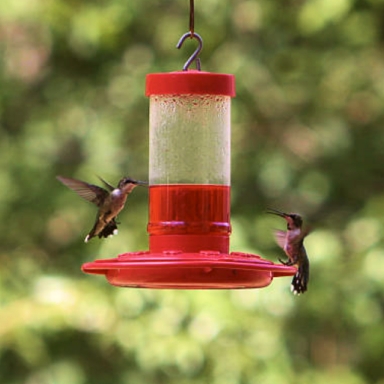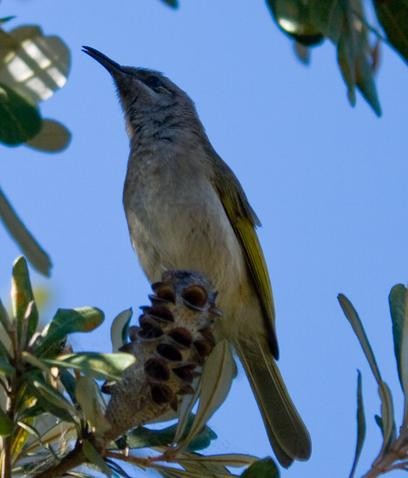Brown Honeyeater
A species of Brown Honeyeaters and Allies Scientific name : Lichmera indistincta Genus : Brown Honeyeaters and Allies
Brown Honeyeater, A species of Brown Honeyeaters and Allies
Botanical name: Lichmera indistincta
Genus: Brown Honeyeaters and Allies
Content
Description People often ask General Info
Description
The brown honeyeater (Lichmera indistincta) belongs to the honeyeaters, a group of birds found mainly in Australia and New Guinea, which have highly developed brush-tipped tongues adapted for nectar feeding. It is a medium-small brownish bird, with yellow-olive panels in the tail and wing, and a yellow tuft behind the eye. Widespread across western, northern and eastern Australia, the brown honeyeater occupies a range of habitats from mangroves to eucalypt woodlands. It is seasonally nomadic within its local area, following flowering food plants. While it usually forages alone, it also feeds in small groups, or flocks of mixed honeyeater species. Nectar and insects form its diet. It occupies the same breeding territory each year, and lays two or three eggs in a cup-shaped nest woven from grass and soft bark. Both sexes contribute to nest building and feeding the young. It has a loud, clear, musical song, described as the best of all the honeyeaters. While the brown honeyeater is declining in some areas, such as the Wheatbelt region of Western Australia, overall its population levels and distribution are sufficient to have it described by the IUCN as being of least concern for conservation. 
Size
16 cm
Colors
Brown
Green
Yellow
Gray
White
Nest Placement
Tree
Feeding Habits
Brown Honeyeater primarily feeds on nectar from flowers like mistletoe and mangroves, and also consumes insects such as beetles and bees. It forages alone or in groups, using a variety of feeding methods, including hovering and perching. With increased morning activity, brown Honeyeater adapts seasonally to ensure energy balance.
Habitat
The brown Honeyeater predominantly occupies wooded areas such as mangrove forests, eucalypt woodlands, and shrublands with proximity to water sources like creeks and estuaries. Flourishing across tropical and subtropical zones, their habitat extends from coastal regions to high-elevation inland woodlands where dense vegetation or tree cover is present, suitable for foraging and nesting. They have adapted to various environments, including monsoon woodlands and suburban areas enriched with flowering plants.
Dite type
Nectivorous
People often ask
General Info
Feeding Habits
Bird food type
Bird Feeder Type

Nectar Feeder
Behavior
A busy, acrobatic bird, the brown honeyeater is frequently on the wing, hovering over flowers and pursuing insects in flight. 
Distribution Area
The brown honeyeater is found in a wide range of wooded habitats, and is widespread across Australia. The nominate race ranges across a broad band from Newcastle on the New South Wales coast north and west to Queensland and the Top End to southwestern Western Australia. It is rarely seen in Sydney, where populations have declined since the late 1950s, though it is being recorded in suitable habitats, such as Homebush Bay and Kurnell in small numbers, and is a vagrant to the Illawarra region. It is rare in South Australia, and not present in Victoria and Tasmania. Population densities range from 2.3 birds per 1 hectare (2.5 acres) in the Kakadu National Park, to 0.26 birds per hectare in Wellard in Western Australia. L. i. ocularis is found in New Guinea, the Torres Strait Islands, and Cape York intergrading with the nominate race along the Gulf of Carpentaria river system. L. i. melvillensis inhabits the Tiwi Islands, while L. i. limbata is found in Bali and the Lesser Sundas, and L. i. nupta on the Aru Islands. The brown honeyeater is seasonally nomadic across its local area in response to flowering food plants. For example, there are marked increases in numbers in Toowoomba in southeast Queensland during winter, and in the Northern Territory the range contracts during the dry season. It is commonly found among mangroves in coastal areas including black mangroves (Rhizophora mucronata). It is often in woodlands that merge into the mangroves, such as those dominated by Banksia, Melaleuca or Callistemon, and widespread in sclerophyll forests and eucalypt woodlands. In the arid and semi-arid inland of Australia, it is most often recorded in Acacia, Grevillea and Hakea shrubland along watercourses, and at bores, springs, and drainage lines. It visits flowering shrubs in parks and gardens, and occurs in remnant patches of trees on travelling stock routes. 
Species Status
The brown honeyeater population is declining in the Wheatbelt region of Western Australia as a result of the clearing of native vegetation. Numbers are increasing in urban areas, particularly in parks and gardens and around farms; however, the new habitats have increased the incidences of death from cats, cars and collisions with windows. Overall the population is sufficiently large and widespread for the brown honeyeater to be considered by the IUCN to be of least concern for conservation. 
